Stone M., Goldbart P. Mathematics for Physics: A Guided Tour for Graduate Students
Подождите немного. Документ загружается.

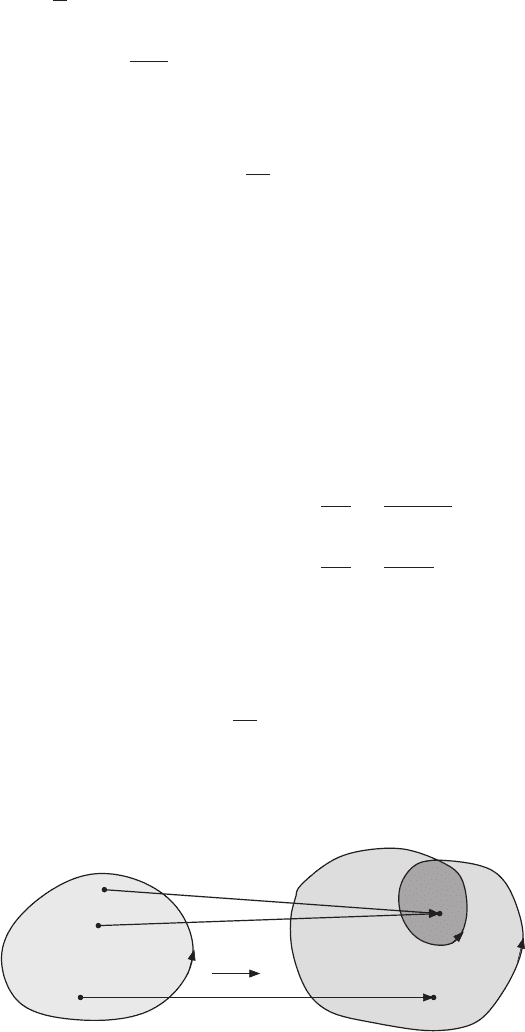
17.5 Meromorphic functions and the winding number 645
Since f
/f =
d
dz
ln f the integral may be written
F
f
(z)
f (z )
dz =
ln f (z) = i
arg f (z ), (17.141)
the symbol
denoting the total change in the quantity after we traverse . Thus
N − P =
1
2π
arg f (z ). (17.142)
This result is known as the principle of the argument.
Local mapping theorem
Suppose the function w = f (z) maps a region holomorphically onto a region
, and
a simple closed curve γ ⊂ onto another closed curve ⊂
, which will in general
have self intersections. Given a point a ∈
, we can ask ourselves how many points
within the simple closed curve γ map to a. The answer is given by the winding number
of the image curve about a (Figure 17.13).
To see that this is so, we appeal to the principle of the argument as
# of zeros of (f − a) within γ =
1
2πi
F
γ
f
(z)
f (z ) − a
dz,
=
1
2πi
F
dw
w − a
,
= n(, a), (17.143)
where n(, a) is called the winding number of the image curve about a. It is equal to
n(, a) =
1
2π
γ
arg (w − a), (17.144)
and is the number of times the image point w encircles a as z traverses the original
curve γ .
f
Figure 17.13 An analytic map is one-to-one where the winding number is unity, but two-to-one
at points where the image curve winds twice.
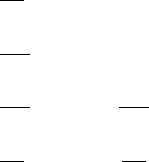
646 17 Complex analysis
Since the number of pre-image points cannot be negative, these winding numbers
must be positive. This means that the holomorphic image of a curve winding in the
anticlockwise direction is also a curve winding anticlockwise.
For mathematicians, another important consequence of this result is that a holomorphic
map is open – i.e. the holomorphic image of an open set is itself an open set. The local
mapping theorem is therefore sometimes called the open mapping theorem.
17.5.2 Rouché’s theorem
Here we provide an effective tool for locating zeros of functions.
Theorem (Rouché): Let f (z) and g(z) be analytic within and on a simple closed contour
γ . Suppose further that |g(z)| < |f (z)|everywhere on γ . Then f (z) and f (z) +g(z) have
the same number of zeros within γ .
Before giving the proof, we illustrate Rouché’s theorem by giving its most important
corollary: the algebraic completeness of the complex numbers, a result otherwise known
as the fundamental theorem of algebra. This asserts that, if R is sufficiently large, a
polynomial P(z) = a
n
z
n
+a
n−1
z
n−1
+···+a
0
has exactly n zeros, when counted with
their multiplicity, lying within the circle |z|=R. To prove this note that we can take R
sufficiently big that
|a
n
z
n
|=|a
n
|R
n
> |a
n−1
|R
n−1
+|a
n−2
|R
n−2
···+|a
0
|
> |a
n−a
z
n−1
+ a
n−2
z
n−2
···+a
0
|, (17.145)
on the circle |z|=R. We can therefore take f (z) = a
n
z
n
and g(z) = a
n−a
z
n−1
+
a
n−2
z
n−2
···+a
0
in Rouché. Since a
n
z
n
has exactly n zeros, all lying at z = 0, within
|z|=R, we conclude that so does P(z).
The proof of Rouché is a corollary of the principle of the argument. We observe that
# of zeros of f + g = n(,0)
=
1
2π
γ
arg (f + g)
=
1
2πi
γ
ln(f + g)
=
1
2πi
γ
ln f +
1
2πi
γ
ln(1 + g/f )
=
1
2π
γ
arg f +
1
2π
γ
arg (1 + g/f ). (17.146)
Now |g/f | < 1onγ ,so1+ g/f cannot circle the origin as we traverse γ .Asa
consequence
γ
arg (1 + g/f ) = 0. Thus the number of zeros of f + g inside γ is the
same as that of f alone. (Naturally, they are not usually in the same places.)
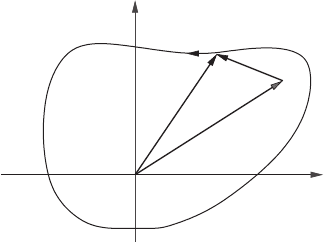
17.6 Analytic functions and topology 647
g
f + g
o
f
Figure 17.14 The curve is the image of γ under the map f +g.If|g| < |f |, then, as z traverses
γ , f + g winds about the origin the same number of times that f does.
The geometric part of this argument is often illustrated by a dog on a lead. If the lead
has length L, and the dog’s owner stays a distance R > L away from a lamp post, then
the dog cannot run round the lamp post unless the owner does the same (Figure 17.14).
Exercise 17.9 : Jacobi Theta function. The function θ(z|τ) is defined for Im τ>0by
the sum
θ(z|τ) =
∞
n=−∞
e
iπτn
2
e
2πinz
.
Show that θ(z+1|τ) = θ(z|τ), and θ(z +τ |τ) = e
−iπτ−2πiz
θ(z|τ). Use this information
and the principle of the argument to show that θ(z|τ) has exactly one zero in each unit
cell of the Bravais lattice comprising the points z = m + nτ ; m, n ∈ Z. Show that these
zeros are located at z = (m + 1/2) + (n + 1/2)τ .
Exercise 17.10: Use Rouché’s theorem to find the number of roots of the equation
z
5
+ 15z + 1 = 0 lying within the circles, (i) |z|=2, ii) |z|=3/2.
17.6 Analytic functions and topology
17.6.1 The point at infinity
Some functions, f (z) = 1/z for example, tend to a fixed limit (here 0) as z becomes
large, independently of in which direction we set off towards infinity. Others, such
as f (z) = exp z, behave quite differently depending on what direction we take as |z|
becomes large.
To accommodate the former type of function, and to be able to legitimately write
f (∞) = 0 for f (z) = 1/z, it is convenient to add “∞” to the set of complex numbers.
Technically, we are constructing the one-point compactification of the locally compact
space C. We often portray this extended complex plane as a sphere S
2
(the Riemann
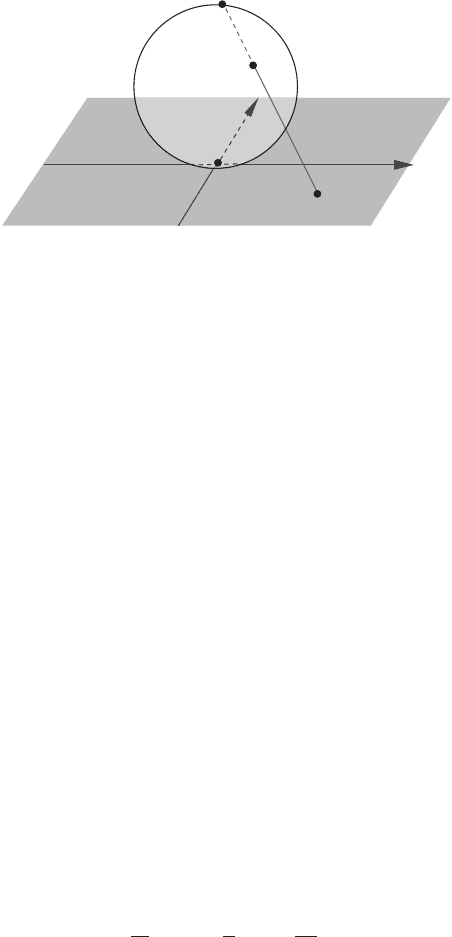
648 17 Complex analysis
N
z
P
S
Figure 17.15 Stereographic mapping of the complex plane to the 2-sphere.
sphere), using stereographic projection (see Figure 17.15) to locate infinity at the north
pole, and 0 at the south pole.
By the phrase an open neighbourhood of z, we mean an open set containing z. We use
the stereographic map to define an open neighbourhood of infinity as the stereographic
image of an open neighbourhood of the north pole. With this definition, the extended
complex plane C ∪ {∞} becomes topologically a sphere and, in particular, becomes a
compact set.
If we wish to study the behaviour of a function “at infinity”, we use the map z (→
ζ = 1/z to bring ∞ to the origin, and study the behaviour of the function there. Thus
the polynomial
f (z ) = a
0
+ a
1
z +···+a
N
z
N
(17.147)
becomes
f (ζ ) = a
0
+ a
1
ζ
−1
+···+a
N
ζ
−N
, (17.148)
and so has a pole of order N at infinity. Similarly, the function f (z) = z
−3
has a zero of
order three at infinity, and sin z has an isolated essential singularity there.
We must be careful about defining residues at infinity. The residue is more a property
of the 1-form f (z) dz than of the function f (z) alone, and to find the residue we need to
transform the dz as well as f (z). For example, if we set z = 1/ζ in dz/z we have
dz
z
= ζ d
1
ζ
=−
dζ
ζ
, (17.149)
so the 1-form (1/z) dz has a pole at z = 0 with residue 1, and has a pole with residue
−1 at infinity, even though the function 1/z has no pole there. This 1-form viewpoint
is required for compatability with the residue theorem: the integral of 1/z around the
positively oriented unit circle is simultaneously minus the integral of 1/z about the

17.6 Analytic functions and topology 649
oppositely oriented unit circle, now regarded as a positively oriented circle enclosing
the point at infinity. Thus if f (z) has of pole of order N at infinity, and
f (z ) =···+a
−2
z
−2
+ a
−1
z
−1
+ a
0
+ a
1
z + a
2
z
2
+···+A
N
z
N
=···+a
−2
ζ
2
+ a
−1
ζ + a
0
+ a
1
ζ
−1
+ a
2
ζ
−2
+···+A
N
ζ
−N
(17.150)
near infinity, then the residue at infinity must be defined to be −a
−1
, and not a
1
as one
might naïvely have thought.
Once we have allowed ∞ as a point in the set we map from, it is only natural to add
it to the set we map to – in other words to allow ∞ as a possible value for f (z). We will
set f (a) =∞,if|f (z)| becomes unboundedly large as z → a in any manner. Thus, if
f (z ) = 1/z we have f (0) =∞.
The map
w =
z − z
0
z − z
∞
z
1
− z
∞
z
1
− z
0
(17.151)
takes
z
0
→ 0,
z
1
→ 1,
z
∞
→∞, (17.152)
for example. Using this language, the Möbius maps
w =
az + b
cz + d
(17.153)
become one-to-one maps of S
2
→ S
2
. They are the only such globally conformal
one-to-one maps. When the matrix
ab
cd
(17.154)
is an element of SU(2), the resulting one-to-one map is a rigid rotation of the Riemann
sphere. Stereographic projection is thus revealed to be the geometric origin of the spinor
representations of the rotation group.
If an analytic function f (z) has no essential singularities anywhere on the Riemann
sphere then f is rational, meaning that it can be written as f (z) = P(z)/Q(z) for some
polynomials P, Q.
We begin the proof of this fact by observing that f (z) can have only a finite number
of poles. If, to the contrary, f had an infinite number of poles then the compactness of
S
2
would ensure that the poles would have a limit point somewhere. This would be a
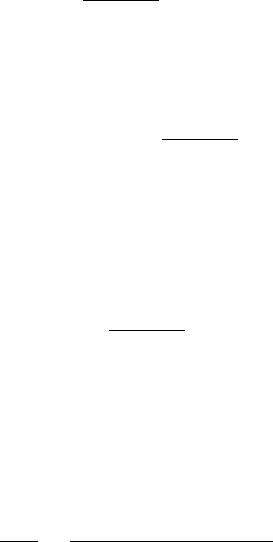
650 17 Complex analysis
non-isolated singularity of f , and hence an essential singularity. Now suppose we have
poles at z
1
, z
2
, ..., z
N
with principal parts
m
n
m=1
b
n,m
(z − z
n
)
m
.
If one of the z
n
is ∞, we first use a Möbius map to move it to some finite point. Then
F(z) = f (z) −
N
n=1
m
n
m=1
b
n,m
(z − z
n
)
m
(17.155)
is everywhere analytic, and therefore continuous, on S
2
. But S
2
being compact and F(z)
being continuous implies that F is bounded. Therefore, by Liouville’s theorem, it is a
constant. Thus
f (z ) =
N
n=1
m
n
m=1
b
n,m
(z − z
n
)
m
+ C, (17.156)
and this is a rational function. If we made use of a Möbius map to move a pole at infinity,
we use the inverse map to restore the original variables. This manoeuvre does not affect
the claimed result because Möbius maps take rational functions to rational functions.
The map z (→ f (z) given by the rational function
f (z ) =
P(z)
Q(z)
=
a
n
z
n
+ a
n−1
z
n−1
+···a
0
b
n
z
n
+ b
n−1
z
n−1
+···b
0
(17.157)
wraps the Riemann sphere n times around the target S
2
. In other words, it is an n-to-
one map.
17.6.2 Logarithms and branch cuts
The function y = ln z is defined to be the solution to z = exp y. Unfortunately, since
exp 2πi = 1, the solution is not unique: if y is a solution, so is y +2π i. Another way of
looking at this is that if z = ρ exp iθ , with ρ real, then y = ln ρ + iθ, and the angle θ
has the same 2π i ambiguity. Now there is no such thing as a “many valued function”.
By definition, a function is a machine into which we plug something and get a unique
output. To make ln z into a legitimate function we must select a unique θ = arg z for
each z. This can be achieved by cutting the z plane along a curve extending from the
branch point at z = 0 all the way to infinity. Exactly where we put this branch cut is
not important; what is important is that it serves as an impenetrable fence preventing us
from following the continuous evolution of the function along a path that winds around
the origin.
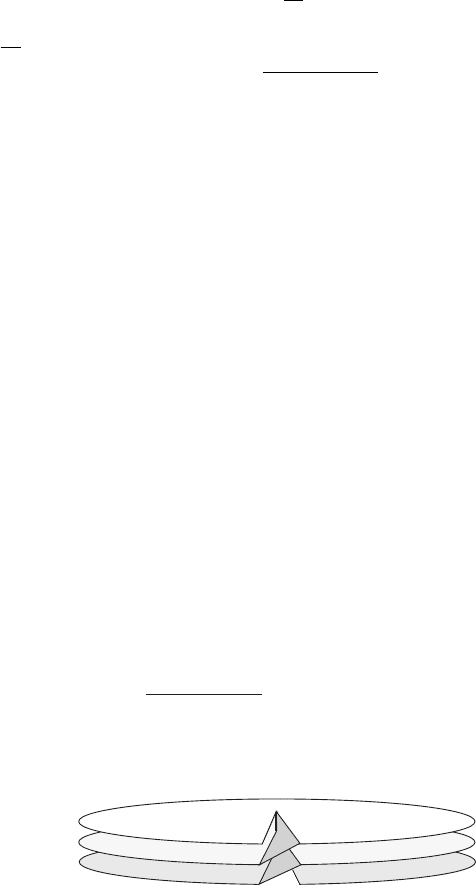
17.6 Analytic functions and topology 651
Similar branch cuts serve to make fractional powers single-valued. We define the
power z
α
for non-integral α by setting
z
α
= exp
{
α ln z
}
=|z|
α
e
iαθ
, (17.158)
where z =|z|e
iθ
. For the square root z
1/2
we get
z
1/2
=
|z|e
iθ/2
, (17.159)
where
√
|z| represents the positive square root of |z|. We can therefore make this single-
valued by a cut from 0 to ∞. To make
√
(z − a)(z − b) single valued we only need to
cut from a to b. (Why? – think this through!)
We can get away without cuts if we imagine the functions being maps from some set
other than the complex plane. The new set is called a Riemann surface. It consists of a
number of copies of the complex plane, one for each possible value of our “multivalued
function”. The map from this new surface is then single-valued, because each possible
value of the function is the value of the function evaluated at a point on a different copy.
The copies of the complex plane are called sheets, and are connected to each other in
a manner dictated by the function. The cut plane may now be thought of as a drawing
of one level of the multilayered Riemann surface. Think of an architect’s floor plan of
a spiral-floored multi-storey car park: if the architect starts drawing at one parking spot
and works her way round the central core, at some point she will find that the floor has
become the ceiling of the part already drawn. The rest of the structure will therefore
have to be plotted on the plan of the next floor up – but exactly where she draws the
division between one floor and the one above is rather arbitrary. The spiral carpark is a
good model for the Riemann surface of the ln z function. See Figure 17.16.
To see what happens for a square root, follow z
1/2
along a curve circling the branch
point singularity at z = 0. We come back to our starting point with the function having
changed sign; a second trip along the same path would bring us back to the original
value. The square root thus has only two sheets, and they are cross-connected as shown
in Figure 17.17.
In Figures 17.16 and 17.17, we have shown the cross-connections being made rather
abruptly along the cuts. This is not necessary – there is no singularity in the function at
the cut – but it is often a convenient way to think about the structure of the surface. For
example, the surface for
√
(z − a)(z − b) also consists of two sheets. If we include the
point at infinity, this surface can be thought of as two spheres, one inside the other, and
cross-connected along the cut from a to b.
O
Figure 17.16 Part of the Riemann surface for ln Z. Each time we circle the origin, we go up one
level.
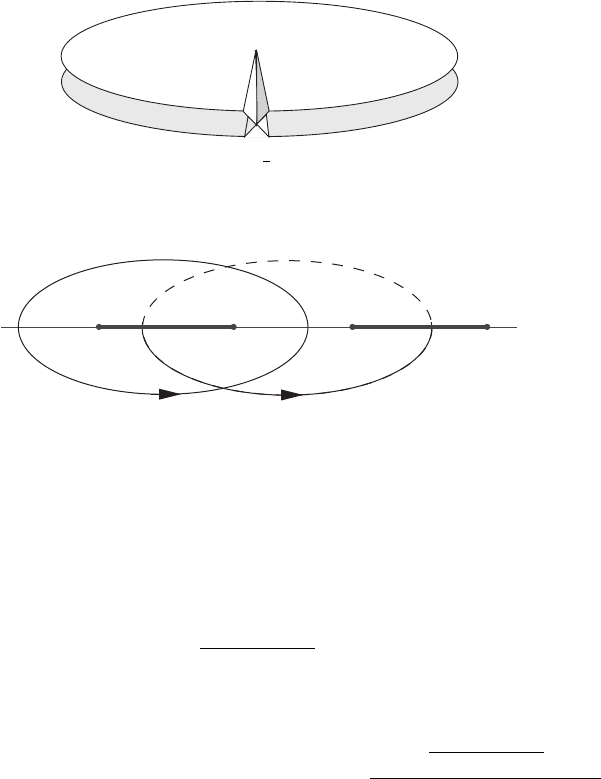
652 17 Complex analysis
O
Figure 17.17 Part of the Riemann surface for
√
z. Two copies of C are cross-connected. Circling
the origin once takes you to the lower level. A second circuit brings you back to the upper level.
abcd
Figure 17.18 The 1-cycles α and β on the plane with two square-root branch cuts. The dashed
part of α lies hidden on the second sheet of the Riemann surface.
17.6.3 Topology of Riemann surfaces
Riemann surfaces often have interesting topology. Indeed much of modern algebraic
topology emerged from the need to develop tools to understand multiply connected Rie-
mann surfaces. As we have seen, the complex numbers, with the point at infinity included,
have the topology of a sphere. The
√
(z − a)(z − b) surface is still topologically a sphere.
To see this imagine continuously deforming the Riemann sphere by pinching it at the
equator down to a narrow waist. Now squeeze the front and back of the waist together
and (imagining that the surface can pass freely through itself) fold the upper half of the
sphere inside the lower. The result is precisely the two-sheeted
√
(z − a)(z − b) surface
described above. The Riemann surface of the function
√
(z − a)(z − b)(z − c)(z −d),
which can be thought of as two spheres, one inside the other and connected along two
cuts, one from a to b and one from c to d, is, however, a torus. Think of the torus
as a bicycle inner tube. Imagine using the fingers of your left hand to pinch the front
and back of the tube together and the fingers of your right hand to do the same on the
diametrically opposite part of the tube. Now fold the tube about the pinch lines through
itself so that one half of the tube is inside the other, and connected to the outer half
through two square-root cross-connects. If you have difficulty visualizing this process,
Figures 17.18 and 17.19 show how the two 1-cycles, α and β, that generate the homol-
ogy group H
1
(T
2
) appear when drawn on the plane cut from a to b and c to d, and then
when drawn on the torus. Observe, in Figure 17.18, how the curves in the two-sheeted
plane manage to intersect in only one point, just as they do when drawn on the torus in
Figure 17.19.
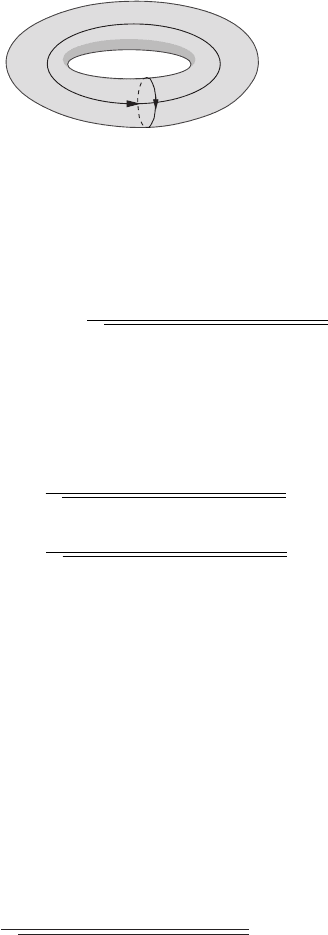
17.6 Analytic functions and topology 653
Figure 17.19 The 1-cycles α and β on the torus.
That the topology of the twice-cut plane is that of a torus has important consequences.
This is because the elliptic integral
w = I
−1
(z) =
z
z
0
dt
√
(t − a)(t −b)(t − c)(t − d)
(17.160)
maps the twice-cut z-plane one-to-one onto the torus, the latter being considered as the
complex w plane with the points w and w + nω
1
+ mω
2
identified. The two numbers
ω
1,2
are given by
ω
1
=
F
α
dt
√
(t − a)(t −b)(t − c)(t − d)
,
ω
2
=
F
β
dt
√
(t − a)(t −b)(t − c)(t − d)
, (17.161)
and are called the periods of the elliptic function z = I (w). The map w (→ z = I(w)
is a genuine function because the original z is uniquely determined by w.Itisdoubly
periodic because
I(w +nω
1
+ mω
2
) = I(w), n, m ∈ Z. (17.162)
The inverse “function” w = I
−1
(z) is not a genuine function of z, however, because
w increases by ω
1
or ω
2
each time z goes around a curve deformable into α or β,
respectively. The periods are complicated functions of a, b, c, d.
If you recall our discussion of de Rham’s theorem from Chapter 4, you will see that
the ω
i
are the results of pairing the closed holomorphic 1-form.
“dw” =
dz
√
(z − a)(z − b)(z − c)(z −d)
∈ H
1
(T
2
) (17.163)
with the two generators of H
1
(T
2
). The quotation marks about dw are there to remind
us that dw is not an exact form, i.e. it is not the exterior derivative of a single-valued
function w. This cohomological interpretation of the periods of the elliptic function is
the origin of the use of the word “period” in the context of de Rham’s theorem. (See
Section 19.5 for more information on elliptic functions.)
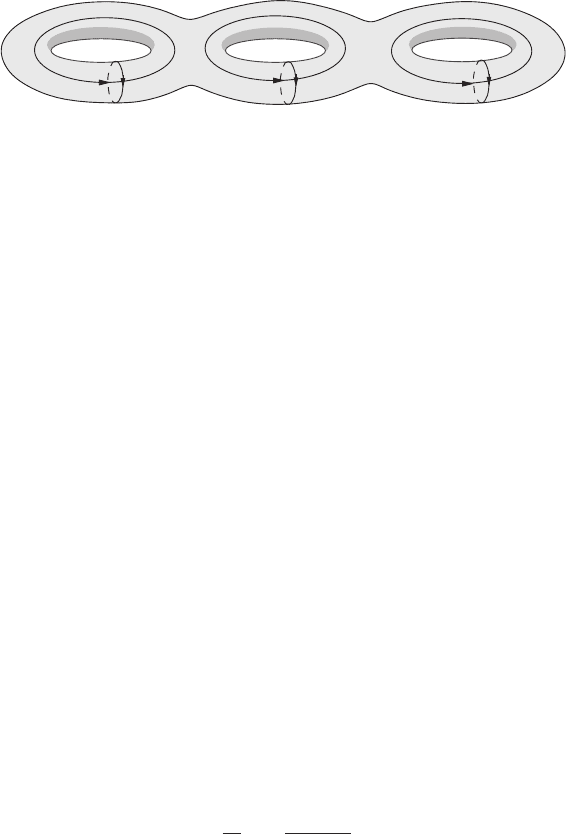
654 17 Complex analysis
1
2
3
3
2
1
Figure 17.20 A surface M of genus 3. The non-bounding 1-cycles α
i
and β
i
form a basis of
H
1
(M ). The entire surface forms the single 2-cycle that spans H
2
(M ).
More general Riemann surfaces are oriented 2-manifolds that can be thought of as the
surfaces of doughnuts with g holes. The number g is called the genus of the surface. The
sphere has g = 0 and the torus has g = 1. The Euler character of the Riemann surface
of genus g is χ = 2(1 −g). For example, Figure 17.20 shows a surface of genus 3. The
surface is in one piece, so dim H
0
(M ) = 1. The other Betti numbers are dim H
1
(M ) = 6
and dim H
2
(M ) = 1, so
χ =
2
p=0
(−1)
p
dim H
p
(M ) = 1 − 6 + 1 =−4, (17.164)
in agreement with χ = 2(1 − 3) =−4. For complicated functions, the genus may be
infinite.
If we have two complex variables z and w then a polynomial relation P(z, w) = 0
defines a complex algebraic curve. Except for degenerate cases, this one (complex)
dimensional curve is simultaneously a two (real) dimensional Riemann surface. With
P(z, w) = z
3
+ 3w
2
z + w +3 = 0, (17.165)
for example, we can think of z(w) as being a three-sheeted function of w defined by
solving this cubic. Alternatively we can consider w (z) to be the two-sheeted function of
z obtained by solving the quadratic equation
w
2
+
1
3z
w +
(3 + z
3
)
3z
= 0. (17.166)
In each case the branch points will be located where two or more roots coincide. The
roots of (17.166), for example, coincide when
1 − 12z(3 + z
3
) = 0. (17.167)
This quartic equation has four solutions, so there are four square-root branch points.
Although constructed differently, the Riemann surface for w(z) and the Riemann surface
for z(w) will have the same genus (in this case g = 1) because they are really one and
the same object – the algebraic curve defined by the original polynomial equation.
